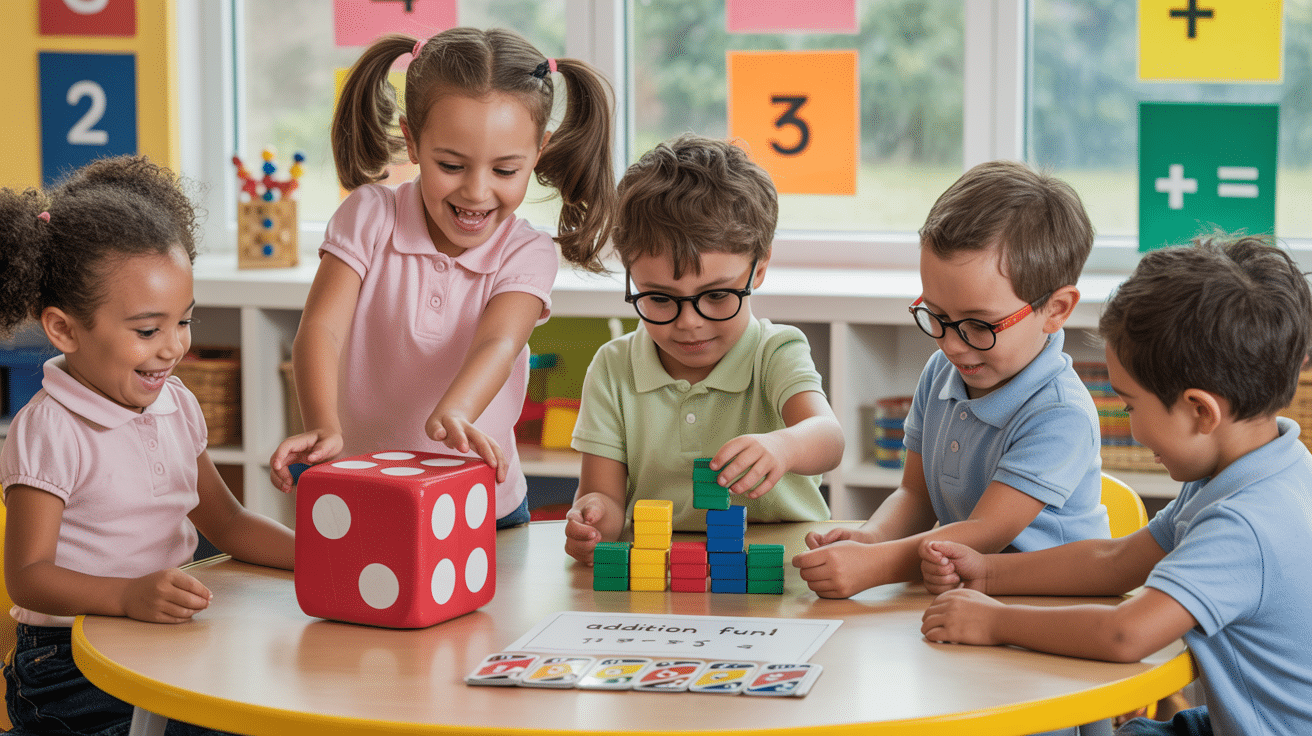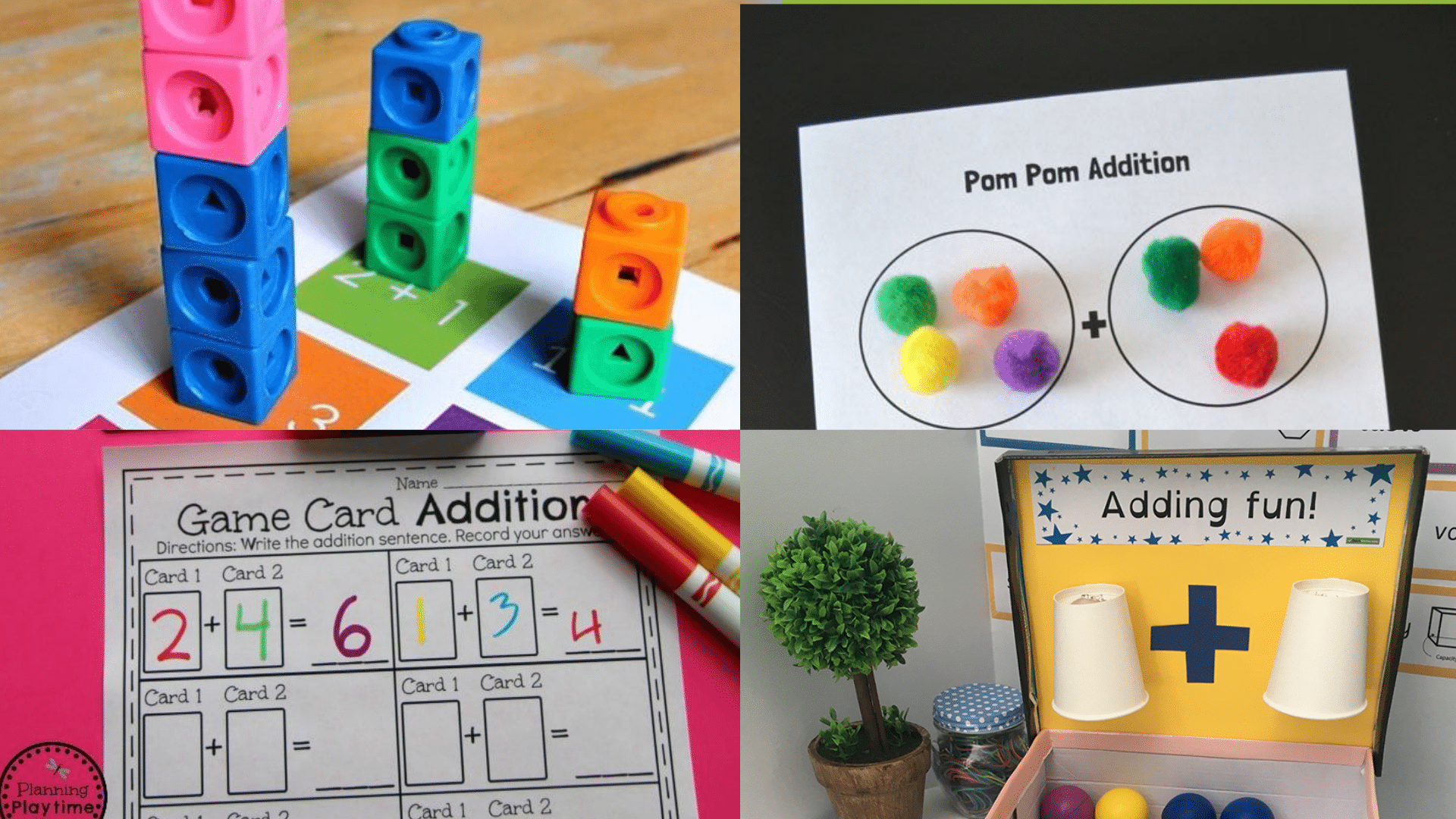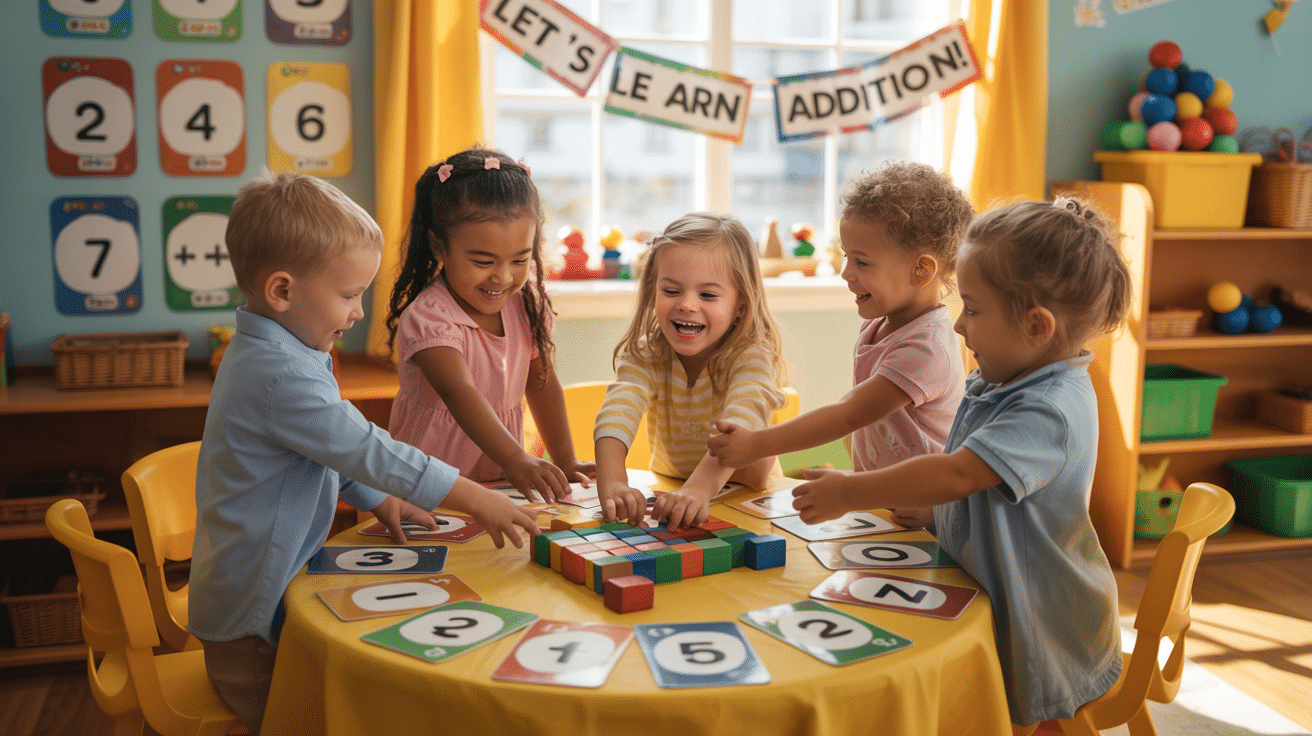Ready to make math fun? These 17 games turn addition into play time for your kindergartners! Kids can roll dice, flip cards, and play with counters while learning numbers. These simple activities need few supplies but keep little ones engaged.
Teachers and parents love them because they work at school or home. Kids love them because they’re exciting! The best part? Children learn math skills without even knowing it.
Try these games today and watch how quickly your students start to understand addition. Their smiles will show you that math can be a blast!
The Benefits of Using Games to Teach Addition in Kindergarten

Games convert the way kindergarteners learn addition, making math an exciting experience rather than a boring worksheet.
Here’s why games are so effective:
Develops Social Skills
Through game-based activities, teachers can create a safe environment for students to practice their social skills and learn how to interact appropriately with their peers in a positive way.
Makes Learning Fun and Engaging
Unlike traditional teaching methods that might lead to disengagement, math games inject an element of fun into learning, turning what may seem like a daunting subject into an enjoyable activity
Boosts Confidence and Motivation
Math games offer a sense of achievement and progress with each successful challenge overcome. This helps boost motivation and confidence in students.
Supports Different Learning Styles
Whether a student is a visual learner who thrives on colorful graphics or a kinesthetic learner who prefers hands-on activities, there’s a math game suited to their needs.
Engaging Addition Games for Kindergarten

Make learning addition fun with interactive games.These games help young learners grasp basic math skills through play.
1. Build Math Block Towers
Children use colorful blocks to build towers representing addition problems.Each block added corresponds to a number, helping kids visualize the concept of combining quantities.
- Materials needed: Building blocks, flashcards with addition problems.
- How to play: Lay out flashcards with simple addition problems. Children use blocks to build towers that represent the sums.
- Skills developed: Number recognition, counting, fine motor skills.
2. Dice Calculator
Roll two dice and add the numbers together.This simple game reinforces number recognition and basic addition skills, making math practice fun and interactive.
- Materials needed: Two dice, paper, and pencil.
- How to play: Children roll both dice, count the dots, and write down the addition equation and sum.
- Skills developed: Counting, addition, writing numbers.
3. Addition Apple Tree
Using a printable apple tree mat, children place a specific number of apples (or counters) on the tree branches to solve addition problems.This visual approach aids in understanding number combinations.
- Materials Needed: Printable apple tree mat, red and green counters or pom-poms.
- How to Play: Children place a certain number of red and green apples on the tree and count the total.
- Skills Developed: Visual addition, counting, color recognition.
4. Dot Sticker Addition
Kids use dot stickers to represent numbers in an addition problem.By physically placing the stickers, they can see how numbers combine, making abstract concepts more concrete.
- Materials needed: Dot stickers, paper, markers.
- How to play: Write an addition problem on paper. Children place the corresponding number of stickers for each addend and then count the total.
- Skills developed: Counting, fine motor skills, number recognition.
5. Parking Lot Addition
Create a “parking lot” with numbered spaces.Children solve addition problems and park toy cars in the corresponding spots, combining math with imaginative play.
- Materials needed: Toy cars, large paper or cardboard, markers.
- How to play: Draw a parking lot with numbered spaces. Write addition problems on the cars. Children solve the problems and park the cars in the correct spots.
- Skills developed: Number recognition, problem-solving, motor skills.
6. Pipe Cleaner Addition
Thread beads onto pipe cleaners to represent numbers in an addition equation.This tactile activity enhances fine motor skills while teaching basic math concepts.
- Materials needed: Pipe cleaners, beads.
- How to play: Children thread beads onto two separate pipe cleaners to represent each addend, then combine them and count the total.
- Skills developed: Counting, fine motor skills, visual addition.
7. UNO Card Addition
Use UNO cards to create addition problems.Children draw two number cards and add them together, turning a familiar game into an educational tool.
- Materials needed: Uno cards.
- How to play: Remove special cards, leaving only number cards. Children draw two cards and add the numbers together.
- Skills developed: Number recognition, addition, quick thinking.
8. Addition Flowers
Each petal of a paper flower contains an addition problem.Children solve the problems and match them to the correct flower center, combining art with arithmetic.
- Materials needed: Construction paper, scissors, markers.
- How to play: Write sums on the center of flowers and corresponding addition problems on petals. Children match petals to the correct flower center.
- Skills developed: Problem-solving, matching, fine motor skills.
9. Fingerpainting Addition Clouds
Draw clouds with addition problems inside.Children use fingerpaint to add “raindrops” beneath each cloud, visually representing the sum in a creative way.
- Materials needed: Paper, finger paints, markers.
- How to play: Write an addition problem inside a cloud. Children use fingerpaint to make the correct number of raindrops representing the sum.
- Skills developed: Counting, creativity, number recognition.
10. Pom-Pom Addition Activity
Using pom-poms and a printable mat, children place a specific number of pom-poms in circles to solve addition problems, making math colorful and hands-on.
- Materials needed: Pom-poms, printable mats, tweezers.
- How to play: Children use tweezers to place the correct number of pom-poms in each circle on the mat, then count the total.
- Skills developed: Fine motor skills, counting, color recognition.
11. Pancake Math Activity
Create “pancakes” from cardboard and write numbers on them.Children stack the pancakes to match addition problems, combining storytelling with math practice.
- Materials needed: Cardboard, markers, scissors.
- How to play: Write numbers on cardboard circles to represent pancakes. Children stack pancakes to match given sums.
- Skills developed: Number recognition, addition, sequencing.
12. Indoor Scavenger Hunt
Hide math problems around the room.Children search for them and solve each one, turning math practice into an exciting experience.
- Materials needed: Paper, markers, tape.
- How to play: Write addition problems on pieces of paper and hide them around the room. Children find and solve each problem.
- Skills developed: Problem-solving, movement, addition.
13. Plastic Egg Addition
Place small objects inside plastic eggs to represent numbers.Children open the eggs and add the contents, making math a surprise-filled activity.
- Materials needed: Plastic eggs, small objects like beads or buttons.
- How to play: Fill eggs with different quantities of objects. Children open two eggs and add the contents together.
- Skills developed: Counting, addition, fine motor skills.
14. Bottle Cap Addition Game
Write numbers on bottle caps and use them to create addition problems.Children physically manipulate the caps to find sums, enhancing number recognition and arithmetic skills.
- Materials needed: Bottle caps, markers.
- How to play: Write numbers on bottle caps. Children pick two caps and add the numbers together.
- Skills developed: Number recognition, addition, tactile learning.
15. Frog Addition Game
Children use frog-themed mats and counters to solve addition problems, hopping their way to the correct sum in a fun, thematic setting.
- Materials needed: Frog-themed mats, counters.
- How to play: Children place counters on lily pads to represent addition problems and find the sum.
- Skills developed: Counting, addition, thematic learning.
16. Fish Math Game
Use fish cutouts with numbers to create addition problems.Children “catch” fish and add their numbers together, combining math with imaginative play.
- Materials needed: Fish cutouts, paperclips, magnets, fishing rod.
- How to play: Attach paperclips to fish cutouts with numbers. Children use a magnetic fishing rod to catch two fish and add the numbers.
- Skills developed: Number recognition, addition, hand-eye coordination.
17. Snowball Addition Game
- Materials needed: Paper, markers, scissors.
- How to play: Write numbers on pieces of paper, crumple them into “snowballs.” children pick two snowballs, open them, and add the numbers together.
- Skills developed: Number recognition, addition, gross motor skills.
Conclusion
Ready to convert your math lessons? These 17 addition games will change how your kindergartners feel about numbers forever! From dice games to pom-pom activities, each game makes learning natural and fun.
The best part? You don’t need fancy materials or hours of prep time. Just grab some common classroom items and watch the math magic happen!
Remember that games do more than teach addition – they build confidence, develop social skills, and create positive math experiences that will last a lifetime.
So put away those boring worksheets and let your students play their way to addition success. Their growing skills and happy faces will be all the proof you need that learning through games really works!




